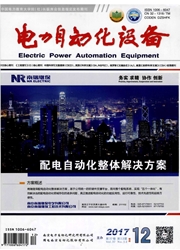

 中文摘要:
中文摘要:
针对传统无功电压聚类分区后各分区中枢点较难定量分析确定的问题,从先定量判别出整个电网的中枢节点再完成无功电压分区的角度,提出将电网所有PV节点松弛为PQ节点,由注入电流形式的潮流方程计算出全网电压越限节点,利用越限节点电压与电网其余节点电压间的线性灵敏度不断校正直到全网节点电压不再越限,通过进一步潮流计算校验,确定所有中枢节点。将全网中枢点数目确定为应划分成的分区数,以节点电压与节点注入无功电流之间的线性灵敏度为无功电压标度,建立无功源控制空间,引入云聚类算法,完成全网节点从无功源控制空间向云模型的转换,进而由云发生器完成以所定中枢点为中心的电网所有节点的聚类软划分。IEEE 14、IEEE 30节点输电网络仿真测试结果,验证了所提方法的有效性。
 英文摘要:
英文摘要:
Since it is difficult to quantitatively determine the pilot nodes after the traditional clusteringbased reactive voltage partitioning,a method is proposed to quantitatively identify the pilot nodes of whole power network before the reactive voltage partitioning,which loosens all PV nodes up to PQ nodes,applies the power flow equations in the form of injecting current to work out the nodes with voltage violation,corrects in turn the voltage-violated node to normal according to its linear sensitivity to the voltages of rest nodes,and determines all pilot nodes by the further power flow calculation verification. The reactive power source control space is built by setting the partition number as the pilot node number and the linear sensitivity of node voltage to its injecting reactive current as the reactive voltage scale. The cloud clustering algorithm is applied to transform the nodes of whole power network from the reactive power source control space to the cloud model and the cloud generator is adopted to realize the clustering-based partitioning with the pilot node as the centre for all nodes of whole power network. The results of simulative test for IEEE14-bus and IEEE 30-bus systems verify the effectiveness of the proposed method.
 同期刊论文项目
同期刊论文项目
 同项目期刊论文
同项目期刊论文
 期刊信息
期刊信息
